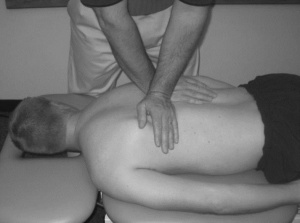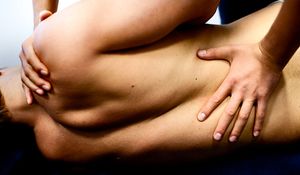Thoracic Manipulation for Shoulder Dysfunction
Original Editor - Carla Benton
Top Contributors - Kim Jackson, Maram Salem, Admin, Dana Tew, Lucinda hampton, WikiSysop and Carla Benton - Your name will be added here if you are a lead editor on this page.
Introduction[edit | edit source]
Cervicothoracic manipulation is a treatment intervention for shoulder dysfunction. In the orthopedic physical therapy setting, shoulder pain and dysfunction is a common diagnosis. Whether the cause may be a rotator cuff, bursa inflammation, degenerative changes in the glenohumeral joint, or spurring, our choices of treatment are varied. Now there is evidence to support the use of manual therapy, that includes thoracic spine thrust manipulation (TSTM). Overall, there is limited but promising evidence supporting the use of cervico-thoracic (CT) mobilization and thrust manipulation for patients with shoulder pain. [1]
Mechanisms for the Effect[edit | edit source]
Thoracic spine and scapular mobility- Thoracic spine forms a key link in the kinematic sequence of arm elevation.
1.Thoracic spine
- Thoracic side bending and rotation are caused by unilateral humeral motions.
- Thoracic rotation and ER indicate significant coupling of these segmental movements. [2]
- Another explanation for use of TSTM with shoulder patients is the relationship of restoring mobility between adjacent vertebrae which may be blocked by entrapment of a meniscoid.
- The relationship between reduced mobility of the cervicothoracic spine and shoulder pain could be explained by this reflexogenic mechanism.
- Abnormal biomechanical relationship between adjacent vertebra can also compress nerve roots, which can affect associated segmental muscular function, such as muscle spasms. This can cause abnormal movement patterns in the shoulder complex , including the scapulohumeral joint.
- Use of manipulative treatment can help our patients not only improve their shoulder mobility, but improve their overall functional performance.
2.Postural dysfunctions
The upper crossed postural syndrome (see also Forward Head Posture) ie the presence of 1.weak deep neck flexors coupled with weak rhomboids and lower trapezius (LT) and 2.Tight pecs coupled with tight upper traps. The position of the scapula on the thoracic wall affects posture, which could affect shoulder function.
3.Regional Interdependance- The clinical rationale for the use of thoracic manipulation with shoulder patients is based on regional interdependence, ie one area directly affects another. If one area, such as the thoracic spine is dysfunctional, it may affect the mobility of the shoulder as well, and create shoulder pain and limitations in function of the upper extremity. [3]
Neurophysiologic[edit | edit source]
Increased scapular strength with manipulation- Improved LT strength following thoracic spine mobilization and thrust manipulation.
Spinal level pain modulation-
- Immediate short-term reduction in numeric pain rating score (NPRS) and shoulder pain and disability index (SPADI) following cervico-thoracic spine manipulation.
- Postural correction in the thoracic spine decreases shoulder pain, and assists with increasing overall shoulder mobility.
- The effects of shoulder, cervical, and thoracic spine high velocity, low-amplitude (HVLA) chiropractic manipulative therapy in the treatment of frozen shoulder showed clinically meaningful changes in reduced pain and disability.
- There may be a relationship between symptoms of the upper extremity CRPS and the thoracic spine.
- Thoracic joint manipulation improved spinal mobility, and also assisted in decreasing distal and autonomic symptoms. This helped to improve overall functional performance of this patient’s upper extremity.
Conclusion[edit | edit source]
One can distinguish from the evidence that our approach to treatment of the shoulder patient should include thoracic manipulation.
- Many physical therapists are not comfortable with manipulation; however, as one can see, it is becoming mandatory to gain these manual skills to deliver successful treatment for our patients.
- Attending continuing education courses, as well as completing residencies, such as Evidence in Motion, can help us stay up with the evidence, and continue to grow our profession as manual experts.
- The challenge is on for all of us, young and old, to become recognized as experts in the treatment of musculoskeletal dysfunctions. We cannot do this without continuing to learn and grow, and using the evidence to help guide our interventions.
Intervention [edit | edit source]
Manual Techniques for the Cervicothoracic Spine
Case Studies[edit | edit source]
The effectiveness of thoracic manipulations on shoulder pain: A Case Report
Resources[edit | edit source]
- Rainbow DM, Weston JP, Brantingham JW, Globe G, Lee F. A prospective clinical trial comparing chiropractic manipulation and exercise therapy vs. chiropractic mobilization and exercise therapy for treatment of patients suffering from adhesive capsulitis/frozen shoulder. Journal of the American Chiropractic Association 2008; September/October: 12-28.
- Menck JY, Requejo SM, Kulig K. Thoracic spine dysfunction in upper extremity complex regional pain syndrome Type I. Journal of Orthopaedic and Sports Physical Therapy 2000; 30:401-409.
References[edit | edit source]
- ↑ Walser RF, Meseve BB, Boucher TR. The Effectiveness of Thoracic Spine Manipulation for the Management of Musculoskeletal Conditions: A Systematice Review and Meta-Analysis of Randomized Controlled Trials. J Man Manip Ther. 2009; 17(4): 237-246.
- ↑ Crosbie J, Kilbreathe SL, Hooman L, York S. Scapulohumeral rhythm and associated spinal motion. Clin Biomechan. 2008; 23: 184-192.
- ↑ Wainner RS, Whitman JM, Cleland JA, Flynn TW. Regional Interdependence: A Musculoskeletal Examination Model Whose Time Has Come. J Ortho Sports Phys Ther. 2007; 37(11): 658-660.










